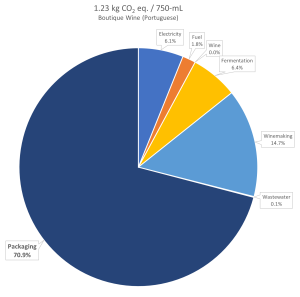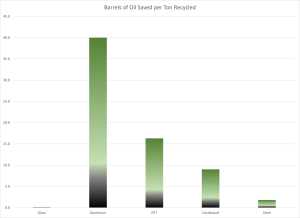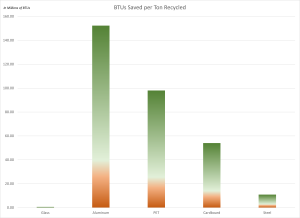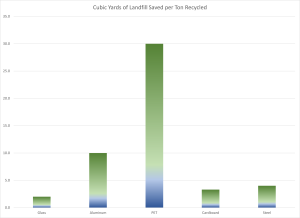It’s Great for Wine, But Not the Environment
Alternative wine packaging has been around since the goat skin bota bag debuted in ancient Greece. Since then the wine industry has experimented with container materials and form factors seeking to discover the best vessel for the beverage and the moment.
That the glass bottle won the industry over is no surprise. Glass is durable, strong, transparent, inert, and can be formed into interesting shapes and sizes. It is relatively inexpensive and easy to make. For many wines it is the penultimate container, as it allows fine wines to mature gracefully for years or decades without any degradation in the bottle nor taint to the wine. No other container has that latter property, which is important to the intrinsic nature of fine wine.
The Dilemma
But glass is not the best container for all wines. According to a 2018 survey conducted by the Sonoma State University’s Wine Business Institute, 90% of wine is enjoyed within two weeks of purchase. The aging properties of glass is not a factor for most wines sold.
Glass bottles are not the best container for many situations in which consumers want to enjoy wine. Glass is breakable, so not appropriate for a day on the beach or at the pool. Bottles are typically 750 mL; many times a person wants only a single glass, and glass bottles don’t reseal for prolonged storage. Festivities often call for a choice of different wines, calling for an array of single-serve options, or to serve from a large format container for simplicity. Large glass bottles are heavy and unwieldy, small bottles aren’t typically available or a good value. Most wines in glass bottles need a corkscrew, which can be highly inconvenient and increases the difficulty in opening them for many people.
Furthermore, glass loses out in almost every metric of impact on climate change. An average of 40% of a typical winery’s carbon footprint is attributed to glass bottle packaging – from manufacturing through its lifecycle of shipping and warehousing, to recycling and its final disposal. A single glass wine bottle can account for between 58% to 71% of the carbon emissions produced in making it according to a Portuguese study:
|
|
|
The industry needs to start considering the alternatives.
The Alternatives
Alternative containers answer many of the faults of glass bottles, both those of convenience and environmental. The latter – the impact on climate change – has become an increasing concern, and the wine industry is beginning to tackle it from the vineyard to the bottle. What are alternative containers for wine?
- Glass bottles – lighter, made from recycled glass, reusable
- Bag-in-box (AKA boxed wine, goon, or box cache)
- Aluminum cans and bottles
- PET bottles and cans
- Aseptic cartons (AKA Tetra Pak®)
- Pliable and rigid pouches
- Steel and PET 19.5-L corny kegs
There are others such as bag-in-bottle, but their market share is minuscule and not growing as fast as the above options. PET cans are also just beginning to enter the market. So when it comes to the market, alternative packaging is already available. Even though glass bottles account for ~77% of the market (in 2021 with sizes 2-L or less), some other containers are beginning to win in the market:
- Bag-in-box – sizes of 20-L or less accounts for 12% of the 2022 global wine market, estimated at $36 billion.
- Aluminum cans – accounts for $253.7 million of the $434.99 billion global wine sales in 2021 or 5.42%.
- Wine kegs – over 8,000 on-premise marketing outlets now offer wine-on-tap in the U.S. in 2022.
- Aseptic cartons (AKA Tetra Pak®) – 7 million cases sold in 2019 in the U.S.
These containers have a smaller but growing presence :
- PET bottles – prevalent in the 187-mL size, they are making small inroads into the 750-mL bottle and single-serve can sizes.
- Aluminum bottles – mostly marketed in the 250-mL size to compete with cans, some prototypes of a 750-mL size have been announced.
A study by Wine Intelligence revealed among the 2,000 regular wine drinkers nearly 50% or more were interested in purchasing wine in alternative formats:
- 42% of those surveyed would buy wine in a 3-L or 5-L bag-in-box.
- 52% would consider single-serve bottles (container material not specified).
- 59% would consider half-bottles (375-mL).
- 42% would consider wine in aluminum cans.
The market is ready for alternative packaging. It provides solutions to glass’ liabilities in both convenience and the environment.
The Benefits
Convenience
Glass Bottles
The glass bottle was a significant improvement on convenience when it became widespread in the 17th century. Prior to that wine was stored and transported in wood barrels (adopted from the Gauls) and clay amphorae. Glass was reserved for special wines. Barrels are good for bulk transport and aging but are heavy and unwieldy, and clay was good for transporting smaller volumes and aging but is fragile and conducive to heat. Glass bottles were lighter, stronger, and inert.
Glass is still the very best material for fine wines that benefit from cellaring. Its properties are such that it can properly store wine for decades allowing it to mature gracefully. What isn’t necessary for aging is thickness; though lighter glass is somewhat more fragile, the thickness of the glass has no effect on aging properly stored wine (obviously thickness is a factor in insulation to some degree).
That benefit – which so far no other material has yet to replicate (though steel likely could age wine for some period) – is why glass will remain dominant in wine packaging for fine wines.
Glass fails in terms of convenience important in our society today. First and foremost it is heavier than any other material. The weight of a 750-mL bottle can range from 300-800 grams (and heavier, especially for sparkling wines, which are 900 g.), and filled can be 2.65 lbs. or more. That translates into case weights of 32 to 40+ lbs.
Glass is traditionally closed with an inserted stopper, which needs a specialized tool to open. Though screw caps are increasingly popular, stoppers from various materials remain dominant. There are too many occasions when a corkscrew is not available, not permitted, or the stopper fails when extracted. Other than the beer crown cap, no other commercial adult beverage requires a specialized tool to open (and some crown caps can be opened by hand).
Finally, glass is somewhat fragile. There are many occasions that are not suitable for glass containers, and prior to the adoption of alternative packaging that meant wine was often not offered as option along with other adult beverages.
The Alternatives
Alternative containers have many convenience benefits that glass bottles do not. They solve many of the issues that glass bottles impose. A simple comparison shows that glass – for most wines – loses out to the alternatives:
| Glass | Bag-in-Box | Aluminum | PET | Steel Keg | PET Keg | Carton Pak | Pouch | |
| Stays fresh after opened | No | Yes | No | No | Yes | Yes | No | Yes |
| Unbreakable | No | Yes | Yes | Yes | Yes | Yes | Yes | Yes |
| No corkscrew | Depends | Yes | Yes | Yes | Yes | Yes | Yes | Yes |
| Lightweight | No | Yes | Yes | Yes | No | Yes | Yes | Yes |
| Transparent | Yes | No | No | Yes | No | Yes | No | No |
| Range of sizes | Yes | Limited | Limited | Yes | N/A | N/A | Yes | Limited |
| Space efficient | No | Yes | Yes | Yes | Yes | Yes | Yes | Yes |
| Age wine | Yes | No | No | No | Yes | No | No | No |
| Resealable | Depends | Yes | Depends | Yes | Yes | Yes | Yes | Yes |
As noted, alternative containers create more opportunities and access to wines in occasions and situations where glass is not suitable. The range of containers and materials creates a range of affordable sizes (single-serve to wine keg) and benefits that glass bottles don’t have. Most key are the benefits that allow for wine in new venues or occasions due to their container’s durability and keeping wine fresh after opening for an extended period of time. The result is that wine becomes a viable choice for consumers more often, and can better compete with other adult beverages.
Environmental
First, some basic environmental terms defined:
- Carbon footprint analysis: (CFA) totals greenhouse gas (GHG) emissions generated by the life-cycle of production, use, process, and disposal.
- Life-cycle assessment: (LCA; includes CFA) totals GHG emissions, land use, water use, and ocean acidification.
- Net zero: greenhouse gases emitted are balanced by GHG removed, either by reduction or removals like offsets.
- Carbon neutral: net zero for CO2 emissions.
- Climate neutral: net zero for all greenhouse gases (including methane, nitrous oxide, and fluorinated gases).
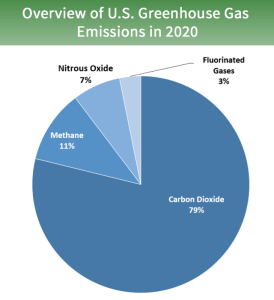
More than just carbon dioxide emissions is responsible for climate change, and any business or organization assessing their climate impact must take into account an array of factors such as water usage, land use, etc., in modifying their operations to be more environmentally conscious.
Glass Bottles
In almost every environmental measure glass loses against the alternatives. A key measurement is the recycling rates of container materials. The news in the U.S. is not very encouraging despite the ability to recycle certain materials, including glass:
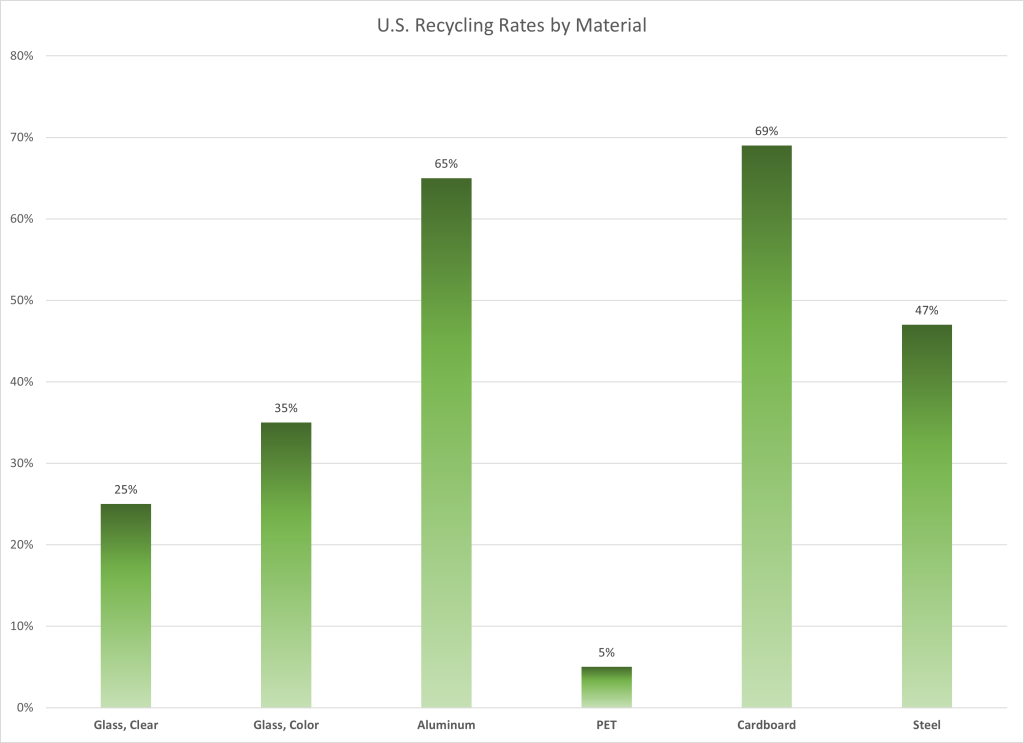
The above is the performance of the recycling processors not the efforts by consumers. PET’s dismal showing is in regards to the various forms of PET and local markets’ ability to recycle them. More PET could and should be recycled. It is also interesting to note that some colors of glass are recycled more frequently than others; the bad news for the wine industry is that green glass is one of the least recycled colors.
In measuring the carbon footprint of each type of alternative container, the impact of glass quickly becomes apparent:
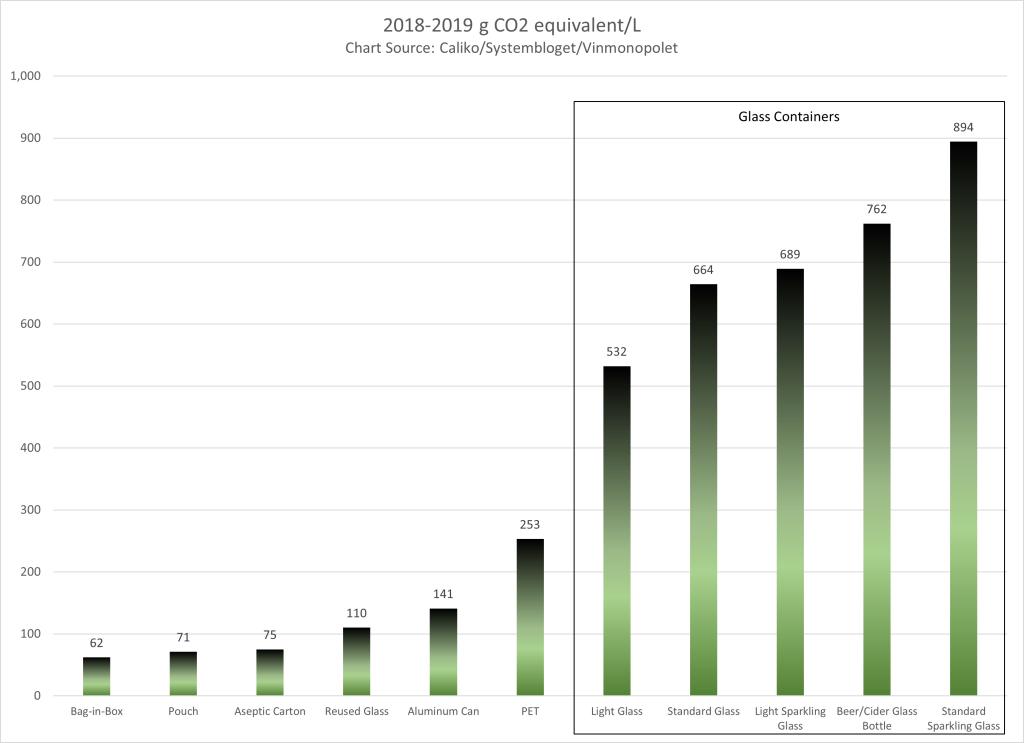
There are many questions yet to be answered on the reused glass category for the U.S.; the above study is focused on the Nordic countries that have more advanced recycling and returnable programs in effect. Returnable glass programs in the U.S. are in the fledgling stages, and so some key questions are still unanswered:
- How many times can a bottle be reused?
- How much heavier does the glass bottle need to be to safe to reuse multiple times?
- What will be the environmental impacts of returning, cleaning, sorting, and repacking glass bottles for sale?
- Will wineries and consumers accept visibly used glass bottles (scuff marks, chips, scratches, etc.)?
- Will enough wineries be willing to standardize around a set number of bottle molds?
Combine the larger carbon footprint of the life cycle of a bottle with the presumed savings from recycling and glass still doesn’t measure up:
|
|
|
|
|
|
Glass is the negligible bar on the left in each category; recycling glass is just as energy intensive as making new glass. Despite its natural beginnings, glass is the least eco-friendly container material for any kind of beverage. In recognition of that, many leaders are calling on the industry to begin considering other the alternatives. Luminaries such as Jancis Robinson and Hugh Johnson have written an open letter calling on the industry to adopt alternative packaging:
“The manufacturing and recycling of glass bottles is wine’s biggest greenhouse gas contributor. In order to minimise the carbon footprint of the wines we drink, we need to seek out wines in alternative packaging wherever possible.”
Wine Traders for Alternative Formats
https://thewtaf.co.uk/open-letter
The Alternatives
A quick comparison of the environmental benefits and disadvantages of containers shows glass trailing the alternatives:
| Glass | Aluminum | Bag-in-Box | PET | Steel Keg | PET Keg | Carton Pak | Pouch | |
| Recyclable | Infinitely | Infinitely | Partially | Limited | Infinitely | Limited | Limited | Limited |
| Decomposes | 4,000+ yrs | <200 yrs | 2+ mos/100 yrs | 450+ yrs | 100-1,000 yrs | 450+ yrs | 5+ yrs | 100 yrs |
| Reusable | Yes | No | No | No | Yes | Yes | No | No |
| Production CO2 | High | Low | Medium | Medium | High | Medium | Low | Low |
| Recycling CO2 | High | Low | Medium | Medium | High | Medium | Medium | Medium |
| Shipping CO2 | High | Low | Low | Low | Medium | Low | Low | Low |
| Weight | Heavy | Light | Light | Light | Heavy | Light | Light | Light |
| Wine Longevity | Years | 18 Months | 18 Months | 18 Months | Years | 18 Months | 18 Months | 18 Months |
Even some of the above environmental benefits noted for glass bottles don’t hold up to scrutiny: glass can be infinitely recycled as a material, but there are no savings to the environment compared to making virgin glass, and reusable/returnable glass bottle programs still have many unknowns on any benefits in comparison to alternative containers. Plus, it must be noted that several studies put glass decomposing in 1,000,000 years, not 4,000. There is some concern that glass-viable sand is diminishing as a resource, and its mining is destructive to communities and the environment.
It also should be noted that other containers have significant liabilities. Bag-in-boxes cannot be fully recycled due to many localities not accepting the inner bag, and no localities accept the plastic tap spigot for recycling. PET can be recycled, but only 1-2 times before the material is too degraded to repurpose. And while many plastics take several hundred years to decompose, most fragment into micro-plastic particles now found throughout the global environment and are becoming a health hazard. Aseptic cartons have layers of aluminum and PET laminated together to increase the longevity of the product’s shelf life, but cannot be recycled as cardboard. Rigid and pliable pouches are laminated layers of materials that also prevent them from being recycled in many localities, and have the same taps as bag-in-boxes.
Once again, glass suffers in comparison in environmental impact. A SommWine Online Wine Course noted, “In fact, Life Cycle Inventory assessments say that even if glass is reused 20 times before being down-cycled, it still emits more greenhouse gas emissions that shipping wine in Bag-in-Box, Tetra Pak®, or in single-use plastic bottles.”
To be environmentally conscious, alternative packaging should be considered in future packaging decisions.
Marketing Alternative Packaging
Younger generations are much more open to alternative packaging. They respond strongly to the messages of convenience, sustainability, and portion control inherent in many alternative containers. The market is ready for alternative packaging.
Glass Bottles
A sizeable portion of wines – especially fine wines – need to be stored in a container for more than 18 months, which is the general limit of almost all of the other alternative containers. Until a better solution comes along, glass bottles are the very best containers for storing wine for years without degradation.
Given that, what can wineries do to improve their environmental footprint if they must use glass bottles? Several ways are possible; the industry can minimize the ecological impacts of glass by:
- Adopting lighter weight glass bottles.
- Purchasing glass bottles made from recycled glass vs. virgin glass.
- Possibly adopting reusable glass bottles with other wineries or consortium.
- Purchasing clear or considering brown/amber glass (better recycling rates).
- Purchasing bottles without punts (unnecessary glass and weight – even for sparkling).
- Using less glass, i.e., no sizes smaller than 750-mL; 1.5-L sizes and up betters the glass-to-wine ratio.
- Marketing the message to recycle.
- Support recycling deposit efforts on wine bottles.
Many of those recommendations run counter to tradition and contemporary marketing (e.g., heavy bottles = better quality wine), but the industry needs to develop the will to market those changes in positive ways that accelerate the adoption of greener glass bottles.
The Alternatives
Marketing Drivers of Alternative Packaging
The benefits of alternative packaging strongly align with the purchasing drivers of consumer behavior:
- Convenience
- Occasion to be consumed
- Sustainability
- Price / cost savings
- Quality
- Portion control
- Variety
- Branding and identification
Purchasing decisions are a complex assessment of the above drivers (and others) that a buyer balances for perceived maximum benefit. Younger generations give more weight to convenience, sustainability, and portion control, and the secondary drivers of social justice and diversity. Furthermore, creative packaging has more appeal to younger generations that view brands’ identities as supplementary to their own.
Building a Marketing Strategy
Assessing these drivers against the buying habits of your customers is vital to making decisions on alternative containers.
However, the first decision should be based on your product portfolio: what type of wines are made and what their price category is. Clearly red and white wines needing more than 18 months in a container either before or after release must continue using a glass bottle. But if your product mix includes wines made to be enjoyed within 18 months of packaging then alternatives may be a more viable choice.
Deciding to use alternative packaging affects the whole of operations. Production must modify winemaking processes specific to the new containers to insure quality. Packing schedules demand more frequent purchases of materials, possibly more packaging materials, and more frequent schedules for packing lines. Accounting must adapt to new unit sizes and case quantities. Marketing must adapt messaging to promote specific containers, and sales needs to identify the best sales channels and target buyers based on container type.
Your marketing and sales strategy must take into account the production needs of alternative packaging, the primary one being a need for a system of just-in-time inventory, which is critical to guaranteeing the freshness of the product. A winery must factor in a 6-8 month packaging cycle to replenish inventory, carefully monitoring sales and depletions and projecting packaging supplies and packing schedules (especially if packing is outsourced to co-packers).
When considering alternative packaging, look at your products from your consumers’ eyes:
- Are they young and adventurous?
- Older and traditional?
- Interested in sustainability and environmental impact?
- Convenience is a factor in their lifestyle choices?
- Wine price a leading driver?
Next, assess your primary sales channels:
- Retail direct to consumer?
- Via tasting room, wine club, and/or website?
- In-state wholesale direct?
- On-premise vs. off-premise?
- Distributor sales?
- Specific to markets?
- Export?
These assessments will guide what your packaging options should be. A long time in coming to the industry is a strategy where wineries consider the market by meeting their buyers’ and consumers’ needs in how, when, and where they want to drink your wines.
A company like Coca-Cola has perfected this approach to market by having a container (or delivery system) for every occasion or venue:
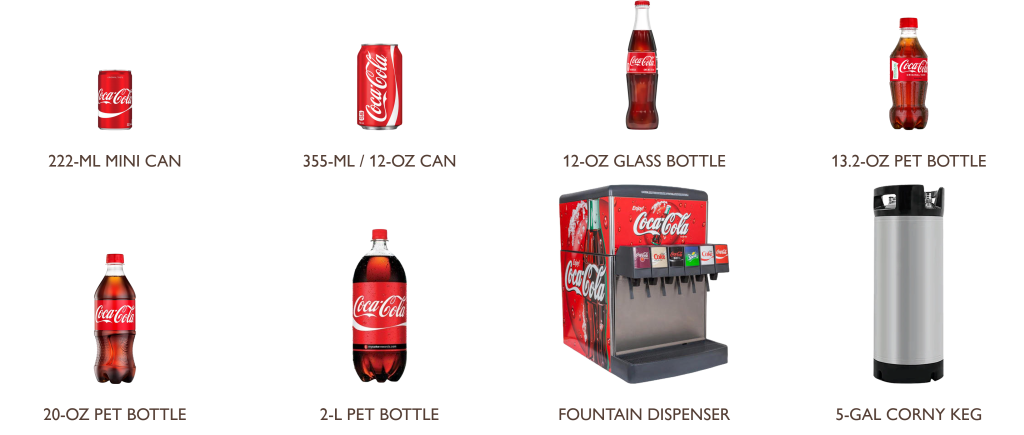
From single-serve to on-premise volume dispensers, Coca-Cola has developed and offers a container for any occasion or venue where a consumer might want their soft drink. This strategy maximizes their potential market. Alternative packaging can give wine producers almost the same range:
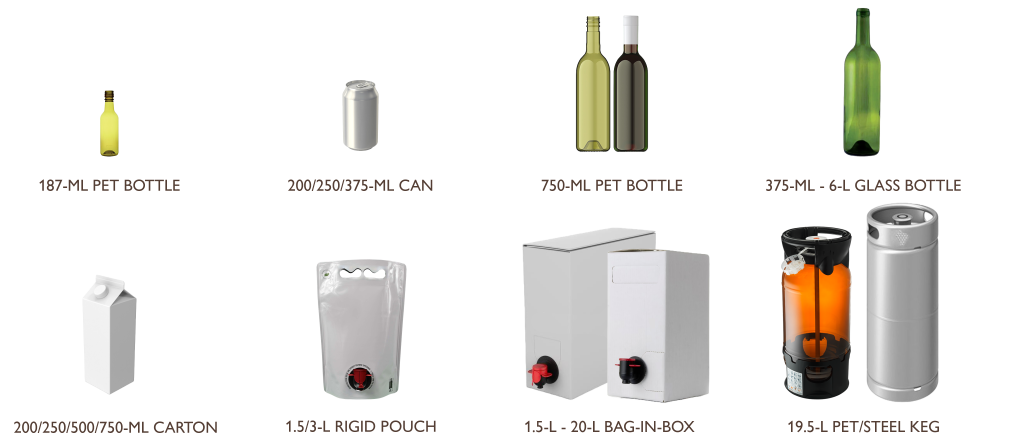
Providing a range of containers presents a bigger challenge for small and mid-size wineries than for large wineries. Small producers contemplating a packaging strategy could extend a product line into just a single-serve can and maintain a 750-mL light glass bottle without complicating their production operations too much. A producer of 10,000 or more 9-L cases (120,000+ 750-mL bottles) or more might be able to manage a range of single-serve (250-mL can or carton), 750-mL (carton or PET bottle), and 3-L offerings (bag-in-box or pouch) that would cover a range of consumer needs. The biggest challenges are managing inventories of packaging supplies and finished product.
In evaluating the potential of alternative wine packaging, group the decision process into five categories:
| PRODUCT | Assess your product portfolio for best fit and potential with alternative containers. |
| TEAM | Discuss adopting alternative packaging with all divisions in the winery. |
| RESEARCH | Survey your sales partners, buyers, and consumers for interest in alternative packaging. |
| MARKET | Begin marketing your decision before you launch your alternatively packaged wines. |
| LAUNCH | Production, marketing, and sales must coordinate to keep inventories low by targeting the appropriate buyers, consumers, and sales channels. |
Summary
There is no better container material for wine than glass. But glass in general is not the best material for convenience and the environment. Shifting packaging to use less or no glass makes good marketing, financial, and environmental sense.
Furthermore, alternative wine packaging opens doors to new sales via new consumers, venues, and occasions for enjoying wine. It expands the potential market for wine.
Climate change is forcing hard questions on the wine industry. The industry has responded primarily through addressing changes in growing and making wine, and through improvements in operations, water use, and energy use. But the biggest factor in a winery’s climate footprint is the glass bottle packaging. Only by making changes to packaging will then wineries realize the most benefit towards slowing climate change.
The wine industry must have the collective will to break with traditions and educate consumers. As beholden to tradition as the wine industry is, it will be an effort to get buyers and consumers to accept change that leaves those traditions behind. Uniting behind lighter, punt-less, and possibly amber-colored wine bottles and offering an array of cans, PET bottles, boxes, pouches, and kegs takes courage and determination to change consumer preferences mostly unchanged since the 17th century. Only collective effort will make change more acceptable and be adopted faster by our customers.



